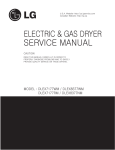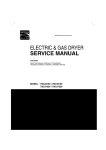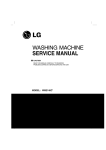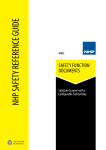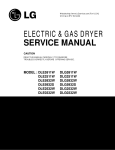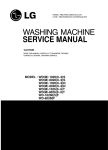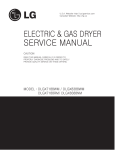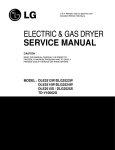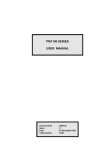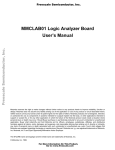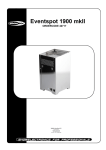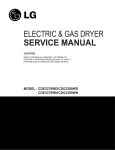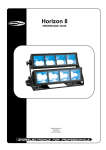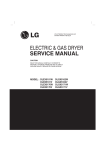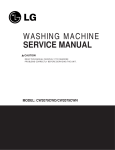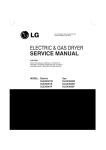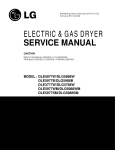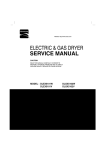Download Service Manual - Appliance Factory Parts
Transcript
Website:http://www.sears.com ELECTRIC & GAS DRYER SERVICE MANUAL CAUTION READ THIS MANUAL CAREFULLY TO DIAGNOSE TROUBLES CORRECTLY BEFORE OFFERING SERVICE. MODEL : 796.8002*.900 / 796.8027*.900 / 796.8031*.900 / 796.9002*.900 / 796.9027*.900 / 796.9031*.900 AUG. 2009 PRINTED IN KOREA P/No.:MFL62119905 IMPORTANT SAFETY NOTICE The information in this service guide is intended for use by individuals possessing adequate backgrounds of electrical, electronic, and mechanical experience. Any attempt to repair a major appliance may result in personal injury and property damage. The manufacturer or seller cannot be responsible for the interpretation of this information, nor can it assume any liability in connection with its use. ! WARNING ! To avoid personal injury, disconnect power before servicing this product. If electrical power is required for diagnosis or test purposes, disconnect the power immediately after performing the necessary checks. RECONNECT ALL GROUNDING DEVICES If grounding wires, screws, straps, clips, nuts, or washers used to complete a path to ground are removed for service, they must be returned to their original position and properly fastened. WHAT TO DO IF YOU SMELL GAS: ■ Do not try to light a match, or cigarette, or turn on any gas or electrical appliance. ■ Do not touch any electrical switches. Do not use any phone in your building. ■ Clear the room, building or area of all occupants. ■ Immediately call your gas supplier from a neighbor’s phone. Follow the gas supplier’s instructions carefully. ■ If you cannot reach your gas supplier, call the fire department. IMPORTANT Electrostatic Discharge (ESD) Sensitive Electronics ESD problems are present everywhere. ESD may damage or weaken the electronic control assembly. The new control assembly may appear to work well after repair is finished, but failure may occur at a later date due to ESD stress. ■ Use an anti-static wrist strap. Connect wrist strap to green ground connection point or unpainted metal in the appliance. - OR - Touch your finger repeatedly to a green ground connection point or unpainted metal in the appliance. ■ Before removing the part from its package, touch the anti-static bag to a green ground connection point or unpainted metal in the appliance. ■ Avoid touching electronic parts or terminal contacts; handle electronic control assembly by edges only. ■ When repackaging failed electronic control assembly in anti-static bag, observe above instructions. 2 CONTENTS 1. SPECIFICATIONS .................................................................................................................4 2. FEATURES AND BENEFITS ................................................................................................... 5 3. INSTALLATION INSTRUCTIONS ........................................................................................... 6 4. COLUMBUS DRYER CYCLE PROCESS ................................................................................... 9 5. COMPONENT TESTING INFORMATION ..............................................................................10 6. MOTOR DIAGRAM AND SCHEMATIC..................................................................................13 7. CONTROL LAY - OUT .........................................................................................................14 8. WIRING DIAGRAM ............................................................................................................15 9. DIAGNOSTIC TEST .............................................................................................................16 9-1. TEST 1 120VAC ELECTRICAL SUPPLY..........................................................................17 9-2. TEST 2 THERMISTOR TEST --- MEASURE WITH POWER OFF .......................................20 9-3. TEST 3 MOTOR TEST ................................................................................................21 9-4. TEST 4 MOISTURE SENSOR .....................................................................................22 9-5. TEST 5 DOOR SWITCH TEST ....................................................................................23 9-6. TEST 6 HEATER SWITCH TEST - ELECTRIC TYPE...........................................................24 9-7. TEST 7 GAS VALVE TEST - GAS TYPE.........................................................................25 10. CHANGE GAS SETTING (NATURAL GAS, PROPANE GAS) ...............................................26 11. DISASSEMBLY INSTRUCTIONS ..........................................................................................28 12. EXPLODED VIEW ..............................................................................................................35 12-1. CONTROL PANEL & PLATE ASSEMBLY.......................................................................35 12-2. CABINET & DOOR ASSEMBLY...................................................................................36 12-3-1. DRUM & MOTOR ASSEMBLY : ELECTRIC TYPE ........................................................37 12-3-2. DRUM & MOTOR ASSEMBLY : GAS TYPE ...............................................................38 3 1 SPECIFICATIONS 796.8002*.900 / 796.8027*.900 / 796.8031*.900 / 796.9002*.900 / 796.9027*.900 / 796.9031*.900 ITEM Color White / Patina Beige Top Plate Spray Door Trim Light Gray Material & Finish POWER SUPPLY 120V / 240V 60Hz (26A) MOTOR 250W (4.5A) AC 120V HEATER 5400W (22.5A) AC 240V ( ELECTRIC TYPE) LAMP 15W (125mA) AC 120V GAS VALVE 13W (110mA) X 2 AC 120V ( GAS TYPE) ELECTRICITY CONSUMPTION CONTROL TYPE Electronic DRUM CAPACITY 7.1 cu.ft. Weight (lbs): Net/Gross 126 / 144 No. of Programs 9 No. of Dry Option 5 No. of Temperature Controls 5 No. of Dry Levels 5 Audible End of Cycle Beeper High / Low / Off Sensor REMARK Moisture Equipped Electro sensor Temperature Equipped Thermistor Reversible Door Adopted Drum Double Coated Steel Dryer Rack Equipped Child lock Equipped Interior Light Equipped Product (WXHXD) 27" x 38" x 28 1/3" Packing (WXHXD) 29 1/2" x 44 3/4" x 30 3/4" 4 2 FEATURES AND BENEFITS Apply Model : 796.8002*.900 / 796.8027*.900 / 796.8031*.900 Apply Model : 796.9002*.900 / 796.9027*.900 / 796.9031*.900 5 3 INSTALLATION INSTRUCTIONS 3-1. POWER CORD 1) 4-wire connection 3. Connect ground wire (green or bare) of power supply cable to external ground conductor screw. Tighten screw. 4. Connect neutral wire (white or center wire) of power supply cord to the center, silver colored terminal screw of the terminal block. IMPORTANT: A 4-wire connection is required for mobile homes and where local codes do not permit the use of 3 wire connections. 1 2 3 4 6 5 1 2 7 1. 4-wire receptacle (NEMA type 14-30R) 2. 4-prong plug 3. Ground prong 4. Neutral prong 5. Spade terminals with upturned ends 6. 3/4 in. (1.9 cm) UL approved strain relief 7. Ring terminals 3 1. External ground connector 2. Green or bare copper wire of power supply cord 3. 3/4 in. (1.9 cm) UL-listed strain relief 4. Center silver-colored terminal block screw 5. Neutral grounding wire (green) 6. Neutral wire (white) 1. Remove center terminal block screw. 2. Remove appliance ground wire (green) from external ground connector screw. Fasten it under center, silver colored terminal block screw. 1 4 5 6 5. Connect the other wires to outer terminal block screws. Tighten screws. 6. Tighten strain relief screws. 7. Insert tab of terminal block cover into slot of dryer rear panel Secure cover with hold-down screw. 2 3 1. External ground connector - Dotted line shows position of NEUTRAL ground wire before being moved to center terminal block screw 2. Center silver-colored terminal block screw 3. Green wire of harness 6 2) 3-wire connection 3) Optional 3-wire connection Use where local codes permit connecting cabinet-ground conductor to neutral wire. Use where local codes permit connecting cabinet-ground conductor to neutral wire. 1 2 4 1. Remove center terminal block screw. 2. Remove appliance ground wire (green) from external ground connector screw. Connect appliance ground wire and the neutral wire (white or center wire) of power supply cord/cable under center, silver colored terminal block screw. Tighten screw. 3. Connect the other wires to outer terminal block screws. Tighten screws. 5 3 7 6 1. 3-wire receptacle (NEMA type 10-30R) 2. 3-wire plug 3. Neutral prong 4. Spade terminals with up turned ends 5. 3/4 in. (1.9 cm) UL approved strain relief 6. Ring terminals 7. Neutral (white or center wire) 1. Loosen or remove center terminal block screw. 2. Connect neutral wire (white or center wire) of power supply cord to the center, silver colored terminal screw of the terminal block. Tighten screw. 1 2 4. Tighten strain relief screws. 5. Insert tab of terminal block cover into slot of dryer rear panel. Secure cover with hold-down screw. 6. Connect a separate copper ground wire from the external ground connector screw to an adequate ground. 3 4 5 1 2 3 1. External ground connector 2. Neutral grounding wire (green) 3. Center silver-colored terminal block screw 4. Neutral wire (white or center wire) 5. 3/4 in. (1.9 cm) UL-listed strain relief 4 3. Connect the other wires to outer terminal block screws. Tighten screws. 4. Tighten strain relief screws. 5. Insert tab of terminal block cover into slot of dryer rear panel. Secure cover with hold-down screw. 1. External ground connector 2. Neutral grounding wire (green) 3. Neutral wire (white or center wire) 4. Grounding path determined by a qualified electrician 7 3-2. Connect Gas Supply Pipe (Gas Dryer ONLY) For further assistance, refer to section on Gas Requirements. 1. Make certain your dryer is equipped for use with the type of gas in your laundry room. Dryer is equipped at the factory for Natural Gas with a 3/8” N.P.T. gas connection. 2. Remove the shipping cap from the gas connection at the rear of the dryer. Make sure you do not damage the pipe thread when removing the cap. 3. Connect to gas supply pipe using a new flexible stainless steel connector. 4. Tighten all connections securely. Turn on gas and check all pipe connections (internal & external) for gas leaks with a non-corrosive leak detection fluid. 5. For L.P. (Liquefied Petroleum) gas connection, refer to section on Gas Requirements. 1 2 5 3 4 1 New Stainless Steel Flexible Connector - Use only if allowed by local codes (Use Design A.G.A. Certified Connector) 2 1/8” N.P.T. Pipe Plug (for checking inlet gas pressure) 3 Equipment Shut-Off Valve-Installed within 6’ (1.8 m) of dryer 4 Black Iron Pipe Shorter than 20’ (6.1 m) - Use 3/8” pipe Longer than 20’ (6.1 m) - Use 1/2” pipe 5 3/8” N.P.T. Gas Connection 8 4 DRYER CYCLE PROCESS Apply Model : 796.8002*.900 / 796.8027*.900 / 796.8031*.900 796.9002*.900 / 796.9027*.900 / 796.9031*.900 * Sensor dry : “Dry Level” is set by users. ** Manual dry : “Temperature control” is set by users. Default settings can be adjusted by users. 9 5 ! COMPONENT TESTING INFORMATION CAUTION When checking the Component, be sure to turn the power off, and do voltage discharge sufficiently. Component 1. Thermal cut off • Check Top Marking : N130 2. Hi limit Thermostat (Auto reset) 3. Outlet Thermostat ( Auto reset) • Check Top Marking : N85 Test Procedure Measure resistance of terminal to terminal ① Open at 284 ± 12°F (140 ± 7°C) ② Auto reset -31°F (-35°C) Same shape as Outlet Thermostat. Measure resistance of terminal to terminal ① Open at 257 ± 9°F (125 ± 5°C) ② Close at 221 ± 9°F (105 ± 5°C) Measure resistance of terminal to terminal ① Open at 185 ± 9°F (85 ± 5°C) ② Close at 149 ± 9°F (65 ± 5°C) Same shape as Thermal cut off. 4. Lamp holder Measure resistance of terminal to terminal 5. Door switch Measure resistance of the following terminal 1) Door switch knob : open ① Terminal : “COM” - “NC” (1-3) ② Terminal : “COM” - “NO” (1-2) 2) Door switch push : push ① Terminal : “COM” - “NC” (1-3) ② Terminal : “COM” - “NO” (1-2) 6. Idler switch Measure resistance of the following terminal : “COM - NC” 10 Check result If thermal fuse is open must be replaced ① Resistance value ≒ ∞ Remark • Heater caseSafety • Electric type ② Continuity (250°F ↓) < 1Ω ① Resistance value ≒ ∞ • Heater case Hi limit • Electric type ② Resistance value < 5Ω ① Resistance value ≒ ∞ • Blow housing Safety • Electric type ② Resistance value < 5Ω Resistance value : 80Ω ~ 100Ω ① Resistance value < 1Ω ② Resistance value ≒ ∞ ① Resistance value ≒ ∞ ② Resistance value < 1Ω 1. lever open ① Resistance value < 1Ω 2. Lever push (close) ② Resistance value ≒ ∞ The state that Knob is pressed is opposite to Open condition. Component Test Procedure 7. Heater Measure resistance of the following terminal ① Terminal : 1 (COM) - 2 ② Terminal : 1 (COM) - 3 ③ Terminal : 2 - 3 ① ② Check result • Electric type ① Resistance value : 10Ω ② Resistance value : 10Ω ③ Resistance value : 20Ω ③ 8. Thermistor Measure resistance of terminal to terminal Temperature condition : 58°F ~ (10~40°C) 58°F ~ 104F (10~40°C) Resistance value : 10Ω 9. Motor 10. Gas valve Remark • Heater case Hi limit • Electric type • See Page 13 valve 1 Measure resistance of the following terminal ① Valve 1 terminal ② Valve 2 terminal • Gas type ① Resistance value : > 1.5kg ~ ② Resistance value : > 1.5~2.5kg valve 2 11. Igniter Measure resistance of terminal to terminal Resistance value : 100~800Ω • Gas type 12. Frame Detect Measure resistance of terminal to terminal ① Open at 370°F ((Maximum) ② Close at 320°F • Gas type 11 ① Resistance value ≒ ∞ ② Resistance value < 1Ω Component 13. Hi-limit Thermostat (Auto reset) Test Procedure Check result Measure resistance of terminal to terminal ① Open at 203 ± 7°F (95 ± 5°C) ① Resistance value ≒ ∞ ② Close at 158 ± 9°F (70 ± 5°C) ② Continuity < 1Ω Remark • Gas type • Gas funnelHi-limit • Check Top Marking : N95 13. Thermal Cut off (Manual reset) Measure resistance of terminal to terminal ① Open at 230 ± 12°F (110 ± 7°C) ② Manual reset • Check Top Marking : N110 12 If thermal fuse is open must be replaced ① Resistance value ≒ ∞ ② Continuity < 1Ω • Gas type • Gas funnelSafety 6 MOTOR DIAGRAM AND SCHEMATIC NOTE When checking Component, be sure to turn Power off, then do voltage discharge sufficiently. Contact On / Off by Centrifugal Switch STOP MODE (When Motor does not operate) RUN MODE (Motor operates) Centrifugal switch (Pull Drive forward) Centrifugal switch 13 7 CONROL LAY - OUT PWB ASSEMBLY DISPLAY LAY-OUT PWB ASSEMBLY LAY-OUT 14 8 WIRING DIAGRAM ! Label all wires prior to disconnection when servicing controls. Wiring errors can cause improper and dangrous operation. Verify proper operation after servicing. ELECTRIC DRYER WIRING DIAGRAM Apply Model : 796.8002*.900 / 796.8027*.900 / 796.8031*.900 A GAS DRYER WIRING DIAGRAM Apply Model : 796.9002*.900 / 796.9027*.900 / 796.9031*.900 15 9 DIAGNOSTIC TEST 1. This TEST should be used for Factory test /Service test. Do not use this DIAGNOSTIC TEST other than specified. 2. Activating the Heater manually with the Door open may trip the Thermostat attached to the Heater, therefore do not activate it manually. (Do not press the door switch to operate the heater while the door is open ) ACTIVATING THE DIAGNOSTIC TEST MODE 1. Unit must be in Standby (unit plugged in, display off) 2. Press POWER while pressing MORE TIME, and LESS TIME simultaneously. Pressing the START/PAUSE button CHECKING ACTION None Electric control & Temperature sensor DISPLAY CHECKING POINT REMARK LQC TEST Won’t power up Detective LED or LCD See test 1 Display: See page LQC TEST Thermistor open LQC TEST Thermistor close Motor runs Once Twice 3 times Motor 70 ~ 255 Displays Moisture Sensor Operation: Measured If moisture sensor is contacted with Moisture Value. damp cloth. The display number is below 180, in normal condition. ELECTRIC TYPE Motor + Heater 1 (2700W) Current Temp. GAS TYPE Motor + Valve ELECTRIC TYPE Motor + Heater 1 Current Temp. +Heater 2 (5400W) (5 ~ 70) GAS TYPE See test 2 See test 3 See test 4 ELECTRIC TYPE: Heater runs GAS TYPE: GAS Valve runs (Display the Temperature of Inside drum.) Gas valve See test 7 Motor, Heater Off Semi-conductor See test 8 Motor + Valve 50~255 Measured 4 times Motor, Heater 5 times Control Off Motor & Heater Off + Lamp On + During check, Buzzer beeps seven times If the door is open. Motor on & Heater During check, If the door is closed. Off + Lamp Off “SE”(Error Display) Auto Off “dE” or “Error” (THE DOOR IS OPEN.PLEASE CLOSE THE DOOR COMPLETELY) 70 ~ 255 16 Door switch Lamp • Press Start button 1 time and then open the door. Proceed again with the step 1 (by pressing start 1 time), step 2 (by pressing start 2 times), step 3 (by pressing start 3 times) and step 4 (by pressing start 4 times) in sequence. • Press Start 2 times and then open the door. Proceed again from the step 1 all the way to the step 4. • Press Start 3 times and then open the door Proceed with the step 1 and skip the step 2 and press step 3 twice and finish with step 4 by making sure the all the electric devices shut off in the end. See test 6 Test 1 120V AC Electrical supply NOTE: To properly check power supply in case of floating neutral or high resistance connections, a load must be applied to the circuit. It is important that the power button be pressed while checking the voltages as described below. With the dryer plugged in, press the POWER button to turn on dryer. YES Check the voltage at the main PCB between WH1-1 (WH) and the black wire on the black tab relay. Is 120 VAC present while pressing the start button? YES •Replace main PCB. •Replace display PCB. NO (NOTE: For gas dryers skip this step.) With the dryer plugged in, check the voltage at the terminal block between the neutral (WH) and L1 (BK) terminals. Is the voltage 120 VAC NO while pressing the START/PAUSE button? •Check power cord. •Check terminal block connection s. YES With the dryer plugged in, check the voltage at the power cord plug between the neutral and L1 (and L2 for electric dryers). Is the voltage 120 VAC while pressing the START/PAUSE button? YES Replace the power cord. 17 NO •Check the power supply fuse or circuit breaker. •Check the receptacle connections. Caution When measuring power, be sure to wear insulated gloves, to and avoid an electric shock. Trouble Symptom Check the Tab Relays Connection properly. Measurement Condition With Dryer Power On; Connector linked to Controller. 1.Power Connection < Table1 > : Connection of the Tab Relay with Heater (Elec) T Tab Relay 1 Tab Relay 2 T a a R High Mid High Medium on on on on Temperature Control below 68±4°C. Turn on Heater1 and Heater2. Low Extra Low on off on off Temperature Control below 52±4°C. Only Turn on Heater1. < Table 2 > : Connection of the Tab Relay with Burner (Gas) T Trans ❈ PCB ASSEMBLY LAYOUT a B R High Mid High Medium O O Temperature Control below 70±4°C. Turn on Burner Low Extra Low O O Temperature Control below 47±4°C. Turn on Burner 2. Status Mode Of The Connection < Table1 > : Connection of Tab Relay with the Tab Relay of the PCB ASSEMBLY (Elec) Connection Color Harness PCB Yellow Wire Check the Matching color Between Harness wire and Tab Relay. (Black Housing – Black Tab Relay) 1 Black 2 Black Wire Connector Housing Connector Housing Tap relay 1 Blue Wire Check the Matching color Between Harness wire and Tab Relay. (White Housing – White Tab Relay) 1 White Remark 2 Black Wire Connector Housing 18 Tap relay 2 < Table 2 > : Connection of Tab Relay with PCB ASSEMBLY (Gas) Color Harness Remark PCB Blue Wire Check the Matching color Between Harness wire and Tab Relay. (Black Housing – Black Tab Relay) 1 Connector Housing Black 2 Black Wire Connector Housing Tap relay 1 3. Status Mode Of wrong Connection < Table1 > : Wrong Connection of the Tab Relay and Connector Housing (Elec) Items ❇ Case Heater1 Operation(black) Heater2 operation(White) PCB condition Of operation 1.Black and White Housing Wire ①, ② CROSS Off Off Power Off 2.Black Housing Wire ①, ② CROSS Off Off Power Off 3.White Housing Wire ①, ② CROSS Normal Normal Power On 4.Black and White Housing Housing CROSS Heater2 Heater1 Power On 5.Black and White Housing Housing and Wire ①, ② CROSS Off Off Power Off < Table2 > : Wrong Connection of the Tab Relay and Connector Housing (Gas) Items 1.Black and White Housing ! Case Heater1 Operation(black) Heater2 operation(White) Off Off Wire ①, ② CROSS PCB condition Of operation Power Off CAUTION - In case of power failure(<Table1>-1,2,5,<Table2>-1), Please check the Connection of “2.Status Table of Connection”. In case of power failure(<Table1>-4), please check the Connection of “2. Status Table of Connection”. Because improper Connection of the equipment-dryer can be damaged of changing heater. 19 Test 2 Thermistor Test---Measure with Power Off Disconnect the NA6 connector from the main PCB. Measure the resistance between the NA6-6 (GN) pin and a chassis ground screw. Is the resistance <1 Ω ? NO YES Measure the resistance between the NA6-1 (RD) and NA6-4 (BL). Does the resistance measured match the temperature of the YES thermistor in the chart? (Use room temperature unless the thermistor is warm from running the dryer.) •Check all wiring harness connections, wires and ground screws. •Replace the main PCB NO Disconnect the thermistor from the harness connector and measure the resistance of the thermistor. Does the NO resistance measured match the temperature of the thermistor in the chart? (Use room temperature unless the thermistor is warm from running the dryer.) YES •Replace the thermistor •Measure resistance of all wires. Resistance should be < 0 Ω. •Check all thermistor harness connectors for corrosion, loose/bent pins, broken wires, etc. •Check all harness wires for cuts, or broken wires. 20 Test 3 Motor test In diagnostic test mode, press the START / PAUSE button. Is the voltage 120 VAC between WH11(WH) and BL3-1 (BN)? NO • Replace main PCB YES With the connectors disconnected, check the resistance between WH11 (WH) and BL3-2 (BN). Is the resistance 2-4 Ω ? Measure with the door closed. YES NO With the connectors disconnected, check the resistance between WH11 (WH) and BL3-3 (YL). Is the resistance 0 Ω ? Measure with the door closed. NO • Recheck voltage at main PCB and replace if no voltage. • Check door switch activation. • Check wiring harness and connections. • See DOOR SWITCH TEST #5. YES With the connectors disconnected, check the resistance between BL2-1 (BN) and BL3-3 (YL). Is the resistance 2-4 Ω ? Measure with the door closed. YES • Recheck voltage at main PCB and replace if no voltage. NO With the connectors disconnected, check the resistance between the terminals of the thermal fuse on the blower housing. Is the resistance 0 Ω ? NO • Replace the outlet thermal fuse. • Check the thermistor (test # 3). • Check exhaust system for restrictions. YES Is the arm of the idler pulley contacting the belt switch lever? (Normal operating position is NO CONTACT.) With the connectors disconnected, check the resistance between terminals 1 and 2 (N.O.) of the belt switch on the motor mount. Is the resistance <1 Ω with no switch contact? YES NO • Check idler pulley and arm. • Check drum belt condition (stretched/broken) • Check drum belt routing • Replace the belt switch. YES • Check Motor. (Refer to MOTOR DIAGRAM AND SCHEMATIC.) • Check if control connector is plugged in. 21 Test 4 Moisture sensor Disconnect the NA6 connector from the main PCB. Measure the resistance between the NO NA6-6 (GN) pin and a chassis ground screw. Is the resistance <1 Ω ? YES •Check all wiring harness connections, wires and ground screws. Put a jumper between NA6-2 (OR) and NA6-4 (BL) to create a circuit connection for the continuity test in the next step. YES Measure the resistance between the two moisture sensor bars on the in the lint filter housing inside the drum. Is the resistance <1 Ω? •Replace the main PCB. YES NO Check all connections and wires between the NA6 terminal at the main PCB and the sensor bars. Check the resistance is 0Ω. YES •Measure the resistance of all wires. Resistance should be < 1 Ω. •Check all sensor harness connectors for corrosion, loose/bent pins, broken wires, etc. •Check all harness wires between the main PCB and the sensor for cuts, or broken wires. 22 Test 5 Door switch test Disconnect the WH1 and BL3 connector from the main PCB. Measure the resistance between the NA6-6 (GN) pin and a chassis ground screw. Is the resistance <1 Ω? NO 3 Disconnect the WH1 and BL3 connector from the main PCB. Measure the resistance between WH1-1 (WH) and BL3-3 (YL). Is the YES resistance < 1 Ω with the door Ω with the door closed and open? •Replace the main PCB. NO BL3 *Skip this step if the dryer does not have a drum light. Disconnect the BL3 and the black tab relay connectors from the main PCB. Measure the resistance between BL3-3 (YL) and the BK wire NO on the black tab relay connector. Is the resistance <1 Ω with the door opened and Ω with the door closed? YES Refer to the individual door switch and light bulb/socket component tests. 23 •Replace the light bulb. •Replace the light socket. Test 6 Heater switch test - Electric Type Enter diagnostic mode and press the START/PAUSE button twice. Measure the voltage between NO YL3-1(WH) and the YL wire on the black tab relay. Is the voltage 240 VAC? •Check power supply. YES YL3 Disconnect the YL3, black tab relay and white tab relay connectors at the main PCB. Measure the resistance between NO YL3-1 (WH) and the YL wire on the black tab relay connector. Is the resistance 18-22 Ω ? YES •Check wiring and connectors to the element. •See element component test. Measure the resistance between YL3-1 (WH) and the BL wire on the white tab relay connector. Is NO the resistance 18-22 Ω ? •Check wiring and connectors to the element. •See element component test. YES Measure the resistance between the YL wire on the black tab relay and the BL wire on the white tab NO relay connectors. Is the resistance 36-44 Ω ? •Check wiring and connectors to the element. •See element component test. YES Measure the resistance between terminals 1 (RD) and the heater NO housing. Is the resistance Ω ? YES Refer to the hi-limit thermostat and thermal cut off component tests. 24 •Replace the element. Test 7 GAS Valve test - Gas Type BL3 Disconnect the BL3 Connector from the main PCB and measure NO the resistance between BL3-1 (RD) and BL3-2 (PK). Is the resistance 1.5k-2.5k Ω ? • Check wiring and connectors to gas valve. • See gas valve component test. YES Measure the resistance between BL3-1 (RD) and BL3-3 (WH). Is NO the resistance 1.5k-2.5k Ω ? • Check wiring and connectors to gas valve. • See gas valve component test. YES YL2 Disconnect the YL3 connector from the main PCB. Measure the resistance between YL3-1 (GY) and YL3-3 (BL). Is the resistance <1 Ω ? NO • Check wiring and connectors to flame sensor. • See flame sensor component test. YES Measure the resistance between YL3-3 (BL) and the blue wire on NO the black tab relay. Is the resistance 100-800 Ω ? • Check wiring and connectors to the ignitor • See ignitor component test YES The flame sensor is closed and the ignitor is OK. • Perform the functional test above. • Check all wiring and connectors to gas valve components. • Check gas supply. 25 10 ! CHANGE GAS SETTING (NATURAL GAS, PROPANE GAS) Warning After Natural Gas Setting, applying Propane Gas Orifice or wrong use of Natural Gas Orifice will result in fire. Conversion must be made by a qualified technician. Initially, Natural Gas mode is set. Propane Gas Orifice is on sale as a Service Part to authorized servicers only. STEP 1 : VALVE SETTING Full open “Change screw” Close “Change screw” STEP 2 : ORIFICE CHANGE ① Remove 2 screws. ② Disassemble the pipe assembly. ③ Replace Natural Gas orifice with Propane Gas orifice. Gas type Orifice P/No Marking Natural Gas 4948EL4001B NCU Propane Gas 4948EL4002B PCU Shape ※ Kit contents : Orifice (Dia. = 1.613mm, for Propane Gas) : Replace Label : Instruction sheet Orifice 26 GAS VALVE FLOW START KEY PUSH VALVE 1 ON (VALVE 2 OFF) IGNITER ON IGNITER TEMPERATURE ABOUT 2499°F(1343°C) NO YES FLAME DETECT OPEN IGNITER OFF 374°C(190°C) VALVE 2 ON NO GAS IGNITION FLAME DETECT CLOSE YES VALVE 2 OFF DRYING GAS IGNITION GAS VALVE STRUCTURE START VALVE 1 ON IGNITER ON OFF FLAME DETECT CLOSE OPEN VALVE 2 OFF ON GAS IGNITION 27 11 DISASSEMBLY INSTRUCTIONS TOP PLATE WARNING When you disassemble the control panel, besure to take gloves and careful panel frame’s edge. Failure to do so can cause serious injury. 1. Remove 3 screws on the upper plate. 2. Push the top plate back ward. 3. Lift the top plate 28 CONTROL PANEL ASSEMBLY WARNING ! When you disassemble the control panel, besure to take gloves and careful panel frame’s edge. Failure to do so can cause serious injury. 1. Remove 2 screws on the control panel frame. 2. Disconnect the connectors. 3. Pull the control panel assembly upward and then forward. 4. Remove 9 screws on the PWB PCB)assembly, display. 5. Remove 4 screws on the PWB(PCB)assembly, main. 6. Disassemble the control panel assembly. 29 COVER CABINET 1. Disassemble the top plate. 2. Disassemble the control panel assembly. 3. Disassemble the door assembly. 4. Remove 2 screws. 5. Remove 4 screws from the top of cabinet cover. 6. Disconnect the harness of door switch. 30 ! WARNING ! TUB DRUM [FRONT] When you disassemble the lamp connector, be sure to take gloves and careful cabinet edge. Failure to do so can cause serious injury. 1. Open the top plate. 2. Remove Cover Cabinet. 3. Disconnect the door lamp and electro sensor connector. 4. Remove 4 screws. 5. Disassemble the Tub Drum [Front]. DRUM ASSEMBLY 1. Open the top plate. -1 -1 2. Remove the Cover Cabinet and Tub drum [front]. -2 3. Disengage belt from motor and idler pulleys. 4. Carefully remove Drum out through front of dryer. CHANGING THE DRUM LAMP 1. Open the door. 2. Remove the screw holding the drum lamp shield in place. 3. Slide the shield up and remove. 4. Remove the bulb and replace with a 15 watt, 120 volt candelabra-base bulb. 5. Replace the lamp shield and screw. 31 DRYER EXHAUST CHANGE ! WARNING ! When you disassemble and install ventilation, be sure to take gloves and careful exhaust edge. Failure to do so can cause serious injury. 1. Remove screw & exhaust duct. 2. Detach and remove the bottom, left or right side PORTION “A” knockout as desired. 3. Reconnect the new duct[11 in(28cm)] to the DUCT TAPE blower housing, and attach the duct to the base. 4. Pre-assemble 4" elbow with 4" duct. Wrap duct tape around joint. DUCT TAPE 5. Insert duct assembly, elbow first, through the side DUCT TAPE opening and connect the elbow to the dryer internal duct. 32 FILTER ASSEMBLY 1. Remove the filter. 2. Remove 3 screws. 3. Pull the grill. 4. Disconnect electro sensor. BLOWER HOUSING 1. Open the top plate. 2. Remove the Cover Cabinet and Tub Drum [Front]. 3. Remove the Drum assembly. 4. Remove 2 screws and cover(Air guide). 5. Remove the bolt and washer. 6. Pull the fan. 7. Disconnect the motor clamp and motor. BACK COVER 1. Open the top plate. 2. Remove the Cover Cabinet and Tub Drum [Front]. 3. Remove the Drum assembly. 4. Remove 7 screws. 5. Pull the Tub Drum [Rear] towards the front. 33 AIR DUCT 1. Open the top plate. 2. Remove the Cover Cabinet. 3. Remove filter and 2 screws. 4. Pull the air duct towards the front. ROLLERS 1. Open the top plate. 2. Remove the Cover Cabinet and Tub Drum [Front]. 3. Remove the Drum assembly and Tub Drum [Rear]. 4. Disconnect Air duct from the Tub Drum [Front]. 5. Remove the roller from the Tub Drum [Front] and Tub Drum [Rear]. 34 12 EXPLODED VIEW 12-1. Control Panel & Plate Assembly A211 A210 A130 A140 A120 A110 35 13-3-2. Cabinet & Door Assembly: Gas type A800 A390 A131 A330 A600 A300 A550 A500 A305 A320 A530 A310 A510 A430 A520 A525 A410 A540 A400 A420 A460 A450 52 13-4-2. Drum & Motor Assembly: Gas type F200 K400 K120 K140 K100 K130 K250 K251 K310 K320 K330 K222 K340 K221 K224 K210 K620 K230 K250 K360 K350 K550 K610 K560 K251 K240 K530 K640 K515 K540 M141 M150 K651 K655 K510 K520 M240 M220 K650 M160 K600 M171 M170 M210 M140 M110 M230 M190 M180 M181 M250 54 12-3-1. Drum & Motor Assembly : Electric Type F200 K400 K120 K140 K100 K130 K250 K251 K310 K330 K320 K340 K222 K620 K221 K230 K210 K250 K360 K350 K610 K550 K251 K560 K240 K530 F140 K540 K510 K651 K520 K640 F130 K650 F110 K600 F120 37







































